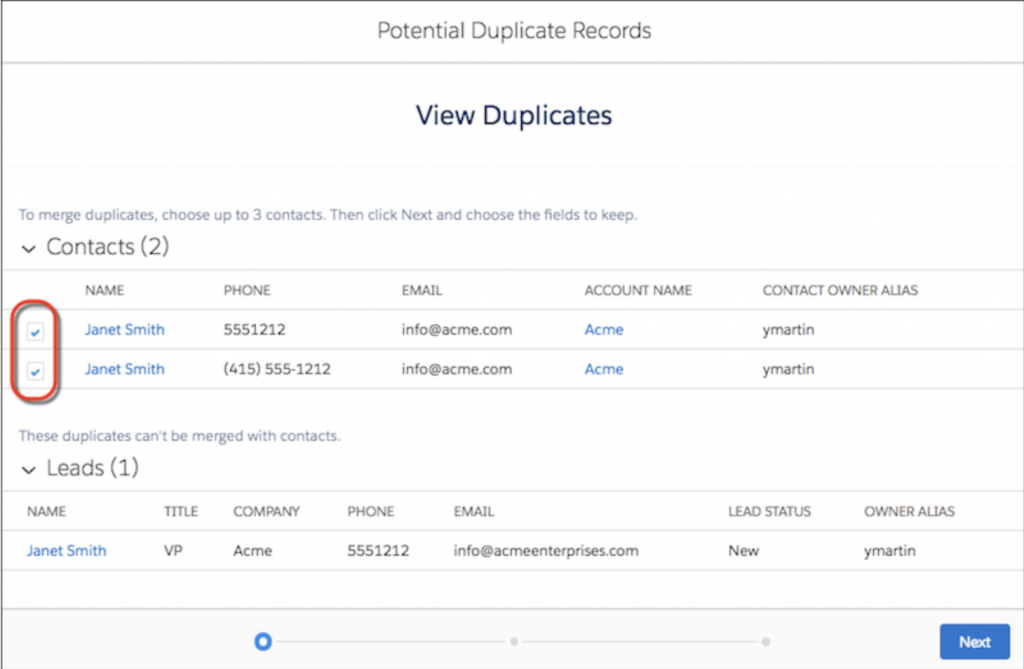Bad data, big costs. Improving the data quality of your business will give you a competitive edge. Why consider paying extra attention to this? Because bad data leads to costly errors and inefficiencies across all levels, which leads to more time spent correcting inaccuracies instead of addressing root causes. Duplicate records are a key component of bad data because it leads to inconsistencies, inaccurate reporting, and, on top all that, negative feedback from prospects.
Over time, data can get jumbled up and be filled with duplicates. This is why certain system clean-up or tech debt exercises, such as that for a data migration, requires careful planning with a clear and detailed scope. During the execution phase of a data migration, cleansing the data may be necessary. Something like this calls for bringing in our own Mass Merge tool—if you couldn’t already tell, we’ve come across and dealt with enough bad data in our line of work that we needed to create a tool to manage it. If you’re already familiar with Salesforce’s out-of-the-box Duplication Rule, then you can only imagine how massive this is!
Mass Merge is a deduplication solution for Salesforce that we built for our clients, enhancing data accuracy through identifying and consolidating duplicate records more efficiently. With a guided process logic builder, Mass Merge can help enforce consistency and accuracy in data entry, reduce data redundancy, improve data quality, and enhance the overall user experience in a handful of steps.
Like we mentioned earlier, Salesforce provides the Duplication Rule out-of-the-box, which is quite convenient when starting out and finding out the best way to maintain quality control over your ever-growing collection of customer records catered to your business requirements. You can set up the criteria that you’re looking for using the Duplication Rule and combine up to three records at a time. So, how does this compare to Mass Merge?
Well, what happens when it gets to the point where three records aren’t enough? The process of manually managing duplicates can become time-consuming and inefficient, especially when faced with a high volume of records. As your business grows, so should the way the business needs to operate.
From our experience, our focus tends to narrow in on the three common objects that usually attract the most duplicated records: Lead, Account, and Contact. Rules are then set up to find which records could be potential duplicates.
Now, let’s imagine that an Account was created by a different Sales Representative every time a customer revisited or reconnected with the company, but each time, the record was created differently. One could be just have captured their email and name; another could have included their name, role, and industry.
At this stage, users can choose to search for duplicates across all accounts or by setting up a duplicate set page to define the criteria to identify potential duplicate records. Mass Merge then searches for records through Salesforce’s Duplicate Rule and generates Duplicate Record Sets that match the criteria and creates a log for review. This log helps to identify duplicates are correctly matched before proceeding with the merge. From here, Mass Merge provides options to determine which record amongst the list of duplicated records should be the Surviving record. When you merge duplicate records, the record that you keep is often referred to as the ‘Winning’ or ‘Surviving record’. This record will consolidate all important details, with the other records being merged into it and then removed, to ensure that only a single accurate record holds all important details for a single customer.
This involves bundling all related tasks and events that were previously spread out across different Salesforce records. All related records will be reparented to the surviving record, which will ensure that no data is lost during the merge. It combines data from the duplicates while keeping the original information on the surviving record. Unless a more advanced Apex Script method is used, existing data on the surviving record will not be overwritten during the merge.
To really show the potential of Mass Merge, let’s bring in a scenario where there are 50+ duplicates for a single person and multiple individuals that need to be deduplicated. Mass Merge can handle up to 100 records at a time per person and process multiple people simultaneously.
Mass Merge provides a simulation mode that lets you preview the final winning record before confirming the deduplication. Our clients have found this particularly helpful, as it offers a clear visual of the final result before any changes are made, ensuring confidence in the deduplication process. Now that’s data freshness!
At the moment, all of our Lane Four Labs packages are free and available to Lane Four clients with active support agreements. Curious to learn more or feeling ready for more efficient processing and up-to-date information about your customers? Let’s chat!

Author: Terrence Wong
Salesforce Administrator

